Rhinoplasty, commonly referred to as a “nose job,” is a popular cosmetic surgical procedure designed to alter the shape, size or proportions of the nose. Whether for aesthetic enhancement or functional improvement, understanding the intricacies of rhinoplasty can help prospective patients make informed decisions. Read along to understand what a rhinoplasty entails.
Understanding the Rhinoplasty Procedure

Rhinoplasty can address a variety of concerns, from reshaping the nasal tip and reducing the size of the nostrils to correcting structural issues that affect breathing. The procedure is tailored to meet individual needs and can be classified into two main types: open and closed rhinoplasty.
Open Rhinoplasty
In open rhinoplasty, the surgeon makes an incision across the columella, the tissue between the nostrils. This approach provides greater visibility and access to the nasal structures, making it ideal for more complex surgeries. It allows the surgeon to make precise adjustments to the bone and cartilage.
Closed Rhinoplasty
Closed rhinoplasty involves incisions made within the nostrils, leaving no visible scars. This technique is typically used for less extensive reshaping and has a shorter recovery time. However, it offers limited access compared to open rhinoplasty.
Both techniques aim to achieve a natural-looking result that complements the patient’s facial features. The choice of method depends on the specific goals of the surgery and the surgeon’s expertise.
Recovery and Swelling
Recovery from rhinoplasty is a gradual process that requires patience and proper care. One of the most significant aspects of the recovery period is managing swelling, which can affect the final appearance of the nose for several months.
Immediate Post-Surgery Swelling
Swelling is an inevitable part of the healing process following rhinoplasty. In the first few days post-surgery, patients can expect significant swelling around the nose and eyes. This initial swelling may be accompanied by bruising and discomfort. Keeping the head elevated and applying cold compresses can help reduce these symptoms.
Long-Term Swelling Management
While the most noticeable swelling subsides within the first few weeks, subtle swelling can persist for several months. The final shape of the nose may not be fully apparent until a year or more after surgery. Patients are advised to avoid strenuous activities, direct sunlight and situations that could risk injury to the nose during the healing period.
Tips for Reducing Swelling
- Stay hydrated: Drinking plenty of water can help reduce swelling.
- Healthy diet: A balanced diet rich in vitamins and minerals supports healing.
- Avoid salt: Reducing salt intake can minimize fluid retention and swelling.
Deciding to undergo rhinoplasty is a personal choice that should be made after careful consideration and consultation with a qualified surgeon. It’s important to have realistic expectations and understand the potential risks and benefits.
Benefits of Rhinoplasty
- Enhanced appearance: Rhinoplasty can improve facial harmony by reshaping the nose.
- Improved breathing: Correcting structural issues can enhance nasal airflow.
- Boosted confidence: Many patients experience increased self-esteem following rhinoplasty.
As with any surgical procedure, rhinoplasty carries risks such as infection, scarring and complications with anesthesia.
Rhinoplasty offers both aesthetic and functional benefits, but it requires a thorough understanding of the procedure and recovery process. Consulting with a skilled surgeon and maintaining realistic expectations can lead to a satisfying and successful rhinoplasty experience. To learn more, contact Hampton Roads ENT ~ Allergy to schedule a consultation today.
